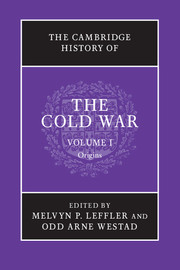Book contents
- Frontmatter
- 1 The Cold War and the international history of the twentieth century
- 2 Ideology and the origins of the Cold War, 1917–1962
- 3 The world economy and the Cold War in the middle of the twentieth century
- 4 The emergence of an American grand strategy, 1945–1952
- 5 The Soviet Union and the world, 1944–1953
- 6 Britain and the Cold War, 1945–1955
- 7 The division of Germany, 1945–1949
- 8 The Marshall Plan and the creation of the West
- 9 The Sovietization of Eastern Europe, 1944–1953
- 10 The Cold War in the Balkans, 1945–1956
- 11 The birth of the People’s Republic of China and the road to the Korean War
- 12 Japan, the United States, and the Cold War, 1945–1960
- 13 The Korean War
- 14 US national security policy from Eisenhower to Kennedy
- 15 Soviet foreign policy, 1953–1962
- 16 East Central Europe, 1953–1956
- 17 The Sino-Soviet alliance and the Cold War in Asia, 1954–1962
- 18 Nuclear weapons and the escalation of the Cold War, 1945–1962
- 19 Culture and the Cold War in Europe
- 20 Cold War mobilization and domestic politics: the United States
- 21 Cold War mobilisation and domestic politics: the Soviet Union
- 22 Decolonization, the global South, and the Cold War, 1919–1962
- 23 Oil, resources, and the Cold War, 1945–1962
- Bibliographical essay
- Index
- References
16 - East Central Europe, 1953–1956
Published online by Cambridge University Press: 28 September 2010
- Frontmatter
- 1 The Cold War and the international history of the twentieth century
- 2 Ideology and the origins of the Cold War, 1917–1962
- 3 The world economy and the Cold War in the middle of the twentieth century
- 4 The emergence of an American grand strategy, 1945–1952
- 5 The Soviet Union and the world, 1944–1953
- 6 Britain and the Cold War, 1945–1955
- 7 The division of Germany, 1945–1949
- 8 The Marshall Plan and the creation of the West
- 9 The Sovietization of Eastern Europe, 1944–1953
- 10 The Cold War in the Balkans, 1945–1956
- 11 The birth of the People’s Republic of China and the road to the Korean War
- 12 Japan, the United States, and the Cold War, 1945–1960
- 13 The Korean War
- 14 US national security policy from Eisenhower to Kennedy
- 15 Soviet foreign policy, 1953–1962
- 16 East Central Europe, 1953–1956
- 17 The Sino-Soviet alliance and the Cold War in Asia, 1954–1962
- 18 Nuclear weapons and the escalation of the Cold War, 1945–1962
- 19 Culture and the Cold War in Europe
- 20 Cold War mobilization and domestic politics: the United States
- 21 Cold War mobilisation and domestic politics: the Soviet Union
- 22 Decolonization, the global South, and the Cold War, 1919–1962
- 23 Oil, resources, and the Cold War, 1945–1962
- Bibliographical essay
- Index
- References
Summary
During the period following Iosif Stalin’s death, the fate of the East Central European region was determined by, on the one hand, the political status quo worked out at Yalta in 1945, and on the other hand, by the unstable and undefined New Course in Soviet policy under the dictator’s successors.
The framework for ensuing developments in Eastern Europe was established at the end of World War II. Both superpowers attributed a pivotal importance to the tacit agreements reached by the Allies at the end of the war to recognize each other’s spheres of interest. This mutual consent came to function as an automatic rule of thumb even in the chilliest years of the Cold War era, and in the coming decades it was to be demonstrated by the West’s continuous inaction whenever the Soviets suppressed sporadic internal conflicts within their bloc. After Stalin’s death, preserving the status quo remained a top priority for Moscow. Even though the incoming administration of Dwight D. Eisenhower launched a propaganda campaign for the “liberation of the captive nations,” the new Soviet leaders never contemplated the surrender of the East Central European Communist states.
The two main elements of the post-Stalin New Course were a strategy of peaceful coexistence and some modification of the Soviet model. The former meant a more fiexible foreign policy and the deepening of political and, especially, economic cooperation with the West, with the aim of improving the Soviet Union’s chances of surviving the intensifying competition between the two blocs. At the same time, in addition to fostering East–West rapprochement, Moscow made efforts to penetrate the Third World and to restore the unity of the Soviet bloc by working toward a reconciliation with Yugoslavia. Within this post-Stalinist vision of a new international order, Moscow endeavored to create a special role for its European allies in which they would act as emancipated and sovereign actors that the West — especially Western Europe — and the Third World could accept as legitimate partners.
- Type
- Chapter
- Information
- The Cambridge History of the Cold War , pp. 334 - 352Publisher: Cambridge University PressPrint publication year: 2010
References
- 1
- Cited by



